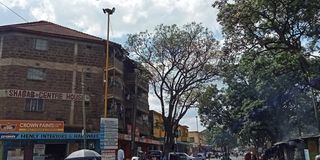Why did matatus stop going into Shabab, Kenlands and Phase Two estates?

Shabab estate attracts a lot of young people in Nakuru city.
For years, estates in Nakuru such as Shabab, Kenlands and Phase Two depended on matatus to connect them to the city centre. Today, however, those same routes tell a different story, with boda bodas now weaving through areas once dominated by matatus, and deserted bus stops marking a quiet shift in how the city moves.
Routes such as Kenlands, Shabab, and Phase Two, which relied on matatus to ferry residents to and from the city centre, have seen many of those vehicles disappear. They have been replaced by the hum of boda bodas, which now define the city’s everyday commute.
Phase Two, for instance, hasn’t seen an active matatu for years. Boda bodas quietly took over after operators abandoned the route due to rising fuel prices.
Caroline Akinyi, a Phase Two resident, remembers how the vehicles vanished about two years ago.
“They just stopped coming. The few that remained joined the Langa Langa Sacco, and nowadays only one matatu, owned by Mzee Willy, does the morning trips. He starts at five and finishes at nine. After that, everyone uses boda bodas or just walks to town,” she says.
The journey she says, is even easier now that Bondeni opened up, and that it only takes minutes to reach Kingdom Seekers church essentially meaning you are in town.
The morning rush allows Mzee Willy to make several trips with other passengers, including market traders who wait for him.
Akinyi explains that this change forced many users to walk to NCCK, where they catch vehicles travelling to Langa Langa.
"The change was also prompted by the rise in fares from Sh20 to Sh30 and finally Sh40 for journeys to and from town. Residents preferred to use boda bodas, which could carry two people for the same price and were much faster. People also complained that the matatus were too old and that vehicles were wasting time circling back for passengers,” she says adding that, in the evening, very few vehicles travel along the route to drop residents home.
Additionally, there was a gradual shift on the Kenlands-Jua Lako route, with talk that the middle class, who were always considered loyal matatu users, were opting for motorbikes to save time.
Matatus on this route were soon left stranded with empty stages as two-wheeled taxis zipped past.
On the Checkpoint, Holy Cross, Heshima and Koinange stretch, morning commuters still struggle to find space in a Matatu. Most vehicles approach from the market side already full, leaving residents with no choice but to wait longer or resort to boda bodas again.
It is only a matter of time before vehicles abandon that route too; they may only survive because the road is a critical passage point.
Meanwhile, other areas have evolved differently. For example, the Ngambo route has seen a surge in matatu numbers, boosted by a growing population and new housing developments in that part of the city. Routes such as Kaptembwa remain vibrant, attracting vehicles that previously served quieter neighbourhoods.
As with everything else in Nakuru, transport culture is evolving alongside the city, becoming faster, sleeker and less communal. The matatus may have defined one era, but the boda bodas are defining the next. Change, after all, is just another ride that Nakuru has learned to take.
